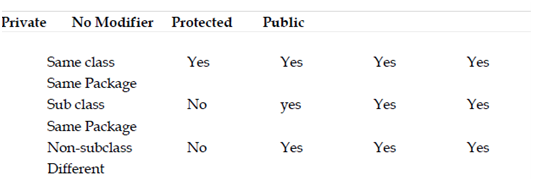Overview Access Specifiers User defined Package Java.lang
We already know that access to a private member of a class is approved only to other members of that class. Package adds another dimension to access control. Java gives various levels of protection to allow fine-grained control over the visibility of variables and functions within classes, subclasses, and packages.
Classes and packages both are means of encapsulating and containing the name space and scope of variables and functions. Package is act like as container for classes and other subordinate packages. Class is act as containers for data and code. java's smallest unit is a class of abstraction. Since of the interplay among classes and packages, it addresses four types of visibility for class members
Subclasses in the package
Non-subclasses in the package
Subclasses in different package
Classes that are neither in the similar package nor subclasses
The three access specifiers that are, public, private, and protected give a variety of ways to produce the several levels of access needed by these categories.
Although java's access control mechanism might seem complicated, we can simplify it as further. Something which declared public could be accessed from anywhere. Anything declared private cannot be seen outside of its class. When member does not have an explicit access specification that member is visible to subclasses as well as to other classes in the similar package. This is the default access. If you need to permit an parts to be seen outside your current package, but only to classes which subclass your class directly after that declare that element protected.


A class only has two possible access levels that are: default and public. Whenever a class is define as public, it is accessible by any other code. It can only be accessed through the other code inside its similar package if a class has default access.
All of the standard java classes involved with java is stored in a package called java. The simple language functions are stored in a package inside of the java package called java.lang. Commonly, you have to import every package or class which you want to use, but because java is useless without much of the functionality in java.lang, it is implicitly imported through the complier for all programs. This is equal to the following line being at the top of all of your programs:
Import java.lang.*;
Package
Java 2 adds a class known as package which encapsulates version data related with a package. The Package version information is becoming more important since of the proliferation of packages and because a java program might required to know what version of a package is available.